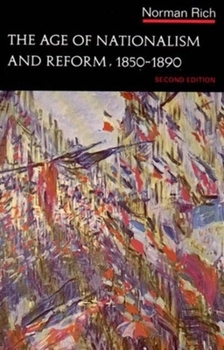The Age of Nationalism and Reform, 1850-1890
(Book #6 in the The Norton History of Modern Europe Series)
Select Format
Select Condition 
Book Overview
The chief sponsor of national revolutions at the beginning of the period was Napoleon III, who hoped to re-establish French ascendancy in Europe, but he was defeated by the forces of a rising and newly unified power-Germany under Bismarck. As in the first edition, Norman Rich traces the spread of nationalism across the continent. He has, however, greatly amplified his treatment of the social and intellectual consequences of industrialization, with particular emphasis on the changing demography of Europe and cultural trends at all levels of society.
Format:Paperback
Language:English
ISBN:039309183X
ISBN13:9780393091830
Release Date:October 1976
Publisher:W. W. Norton & Company
Length:288 Pages
Weight:0.85 lbs.
Dimensions:0.7" x 5.4" x 8.3"
Customer Reviews
2 ratings
Good lightweight intro to the period
Published by Thriftbooks.com User , 16 years ago
This is the second book in the Norton History of Modern Europe which I have read, the first being Felix Gilbert's The End of the European Era (1890 to the Present), which is the last book in the Norton series and is highly recommended. This book is quite brief at 250 pages; however these pages are filled with very useful information about the period, more so than `scholarly tomes' with obscure references that tend to lose the `casual' student of history in details. The only complaint I have with this book is the scarcity of maps, something which would be useful in aiding the understanding the major battles of the period. Generally however this is a very useful book and I would recommend this to someone like myself whose knowledge of history, except in very broad strokes, is quite limited.
Good Overview
Published by Thriftbooks.com User , 18 years ago
At just over 200 pages, THE AGE OF NATIONALISM AND REFORM comes across as a little lightweight, but not so much that it hasn't been a classic steady-seller for publisher W. W. Norton. Just as the title implies, mid 19th-Century Europe was not a time of revolution but a time of growing nationalism and reform, as the middle (read: upper middle) class in nation after nation gained political and purchasing power amid a rapidly increasing standard of living. Consider that Baron Hausmann's reconstruction of Paris in the 1850s-1860s would cost one TRILLION U.S. dollars if attempted today! But nationalism was a mixed blessing: it could unite Italy but also form zealous and jealous nation-states and empires. By the time the book ends ca. 1890, the power blocs that would start and pursue "The Great War (WWI)" are very much in evidence. Budget-minded professors and students might want to consider that the price of this paperback is a breathtaking $20.60 (the first edition in 1970 cost all of two-fifty). Similar texts are available for less money, but after thirty-five years of steady publication used copies are easy to find.






